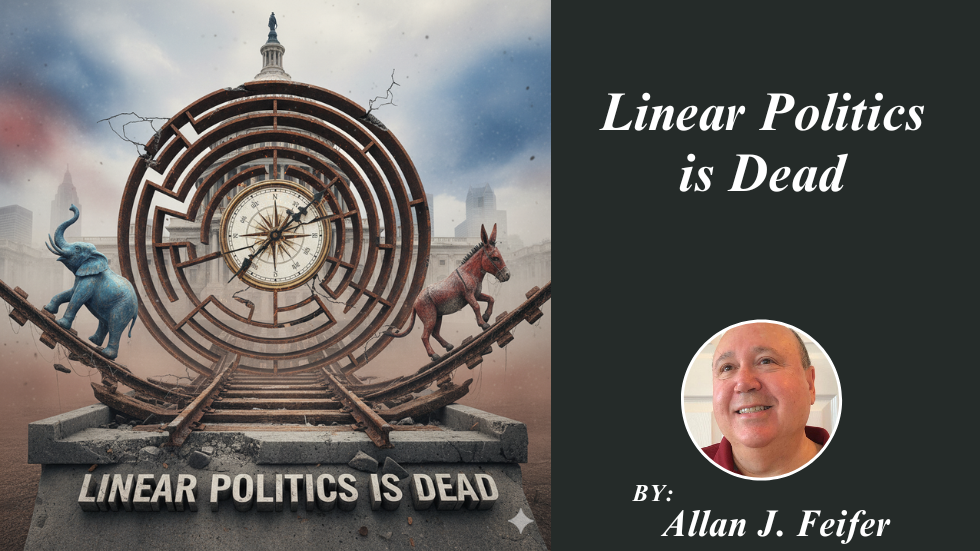My entire life, I’ve understood politics as linear, extending from the far left to the far right. We dropped names —monikers, if you will —in various spots along the spectrum. Communists, socialists, anarchists, left-wing populists on the left, ultranationalists, religious fundamentalists, fascists, neo-fascists, and right-wing populists on the right, all distinct. Except now you can begin to visualize an unholy alliance between the far left and the far right, more of a circle than the traditional left/right paradigm. A temporary marriage of convenience, perhaps, but what if it’s not? What if it’s a way to move effortlessly from one side to the other for reasons of political expediency? Do you recall the character Viktor Komarovsky in Doctor Zhivago?
Politics and contemporary polarization are beginning to align. While ideological endpoints still differ in their ultimate goals, the tactical, rhetorical, and sometimes institutional alignments between elements of the far left and the far right produce a topology better viewed as a circle than a line. The circular model still preserves the differences in traditional ends while explaining how opposites converge at points of shared method, enemy, and opportunity. And, maybe, just maybe, reveals a lack of political purity with some of those leaders. Look no further than Democrats in Washington, frantically trying to remove themselves from the quicksand they find themselves in. Which direction will they look to for leadership? If embracing socialism is the direction they go, what does that say about their morality?
Background:-
The linear left–right model organizes political actors along axes of economic and social policy. On the progressives push for collective ownership, redistribution, egalitarianism, and anti-hierarchical communists, socialists, anarchists, and left-wing populists. On the right are actors who emphasize hierarchy, tradition, national sovereignty, and cultural cohesion—ultranationalists, religious fundamentalists, fascists, neo-fascists, and right-wing populists. For decades, this axis made analytical sense: it mapped policy trade-offs, coalition prospects, and predictable antagonisms.
But the linear model assumes orthogonality between means and ends: that the tactics and rhetorical tools used to pursue goals align with ideological rhetoric. Recent developments reveal that this assumption is false. Different ideological endpoints sometimes adopt identical methods and narratives against shared targets, creating functional alliances that cross sides. The result is a topology where extremes can meet on a perimeter—hence the circle metaphor.
Mechanisms of Convergence:-
Several mechanisms drive the emergence of cross-spectrum alignment.
- Shared enemies. Both extremes often identify the same institutional targets: liberal elites, mainstream media, large tech platforms, international institutions, or perceived politically correct or corrupt organizations. This convergence of grievances produces shared short-term objectives that encourage tactical cooperation.
- Tactical imitation. Protest playbooks, legal strategies, and media manipulation techniques circulate across ideological boundaries. Direct action tactics, use of legal loopholes, coordinated online disinformation, and performative spectacle are learned and reused irrespective of political attachment.
- Epistemic collapse. Mutual skepticism toward mainstream epistemic authorities—universities, legacy media, scientific institutions—creates fertile ground for conspiratorial narratives and shared dogma. When both sides delegitimize the same sources of authoritative knowledge, they can lay claim to overlapping audiences who see distrust as a virtue.
- Issue-specific alignment. On discrete issues—trade, foreign intervention, civil liberties, surveillance, or corporate power—portions of the left and right arrive at identical policy positionsfor different reasons. These convergences can produce temporary coalitions around legislation, protests, or tactics.
- Platform dynamics and algorithmic amplification. Social media rewards engagement, not coherence. Algorithms amplify melodramatic but shared content, making encounters between ideological extremes frequent, visible, and performative.
Indicators:-
- Tactical coalitions. Temporary alliances form around single-issue protests, legal cases, or electoral strategies (Queers for Palestine). These coalitions do not erase ideological conflict but exploit narratives to achieve immediate aims that bolster short-term gain and enhance a group’s viability and bona fides.
- Rhetorical convergence. Anti-elite and anti-establishment rhetoric is constantly recycled. Phrases that delegitimize institutions have a dual audience: for left audiences, they signal anti-capitalism; for right audiences, they signal anti-globalism. Rhetoric unintentionally becomes a bridge despite opposing endgames.
- Institutional crossovers. Sometimes organizations or media begin with a single ideological orientation, migrate or fragment, producing intersections where recruitment, fundraising, or mobilization draws on both extremes. These hybrid institutions operate as structural sinew connecting distant points on the periphery.
Persistence:-
The circle metaphor explains how tactical proximity works.
- Divergent ends. The far left generally imagines a more egalitarian social order and a redistribution of material conditions. The far right often seeks ethnonational homogeneity, hierarchical social orders, or religiously ordered states.
- Durability of alliances. Convergences are frequently tactical, fragile, and contingent. Once a shared target is neutralized or circumstances change, the coalition dissolves or turns hostile. Tactical cooperation is therefore predictably temporary.
- Underlying constituencies and narratives. The historical roots, cultural narratives, and recruitment pipelines that nourish far-left and far-right movements remain different, resisting integration.
Inferences:-
Adopting a circular topology has practical and analytical consequences.
- Predicting political behavior requires attention to tactics, grievances, and communication channels rather than a reliance on stated ideologies.
- Institutional resilience faces new stressors. Norms that once assumed precise alignments—journalistic objectivity, party gatekeeping, legal interpretations—must contend with omnipresent, difficult-to-counter coordinated delegitimization campaigns.
- Policy design and countermeasures need nuance. Responses that treat threats solely as left- or right-wing risks miss hybridized campaigns. Regulators and civil society must differentiate between actual intent and posturing, reacting accordingly.
Conclusion:-
The circle does not mean the far left and far right have morphed into a single ideology. Instead, it highlights a structural reality: opposites sometimes attract, touch, collaborate, and mirror one another at the perimeter. One more thing I see evolving: As members of the far left or right age, disillusionment sets in, as it is difficult, if not impossible, to topple the status quo. Today’s radical is tomorrow’s conformist. Recently, President Ahmad al-Sharaa of Syria, once a member of Al Qaeda, took the pragmatic step of joining the establishment, which was recently feted at the White House. Other far-right and far-left radicals, like Mamdani, Squad members, and many others, who used to be on the fringe, have now been transmogrified into what passes for the mainstream. We should all be very circumspect and on the lookout for wolves in sheep’s clothing!
God Bless America!
Author, Businessman, Thinker, and Strategist. Read more about Allan, his background, and his ideas to create a better tomorrow at www.1plus1equals2.com. Read additional great writers here.
You may also enjoy these Articles, published on National Platforms




Recent Comments